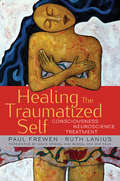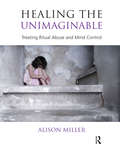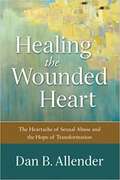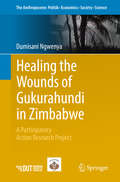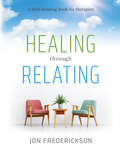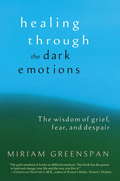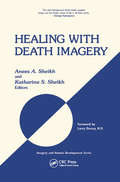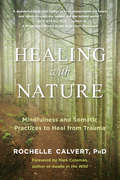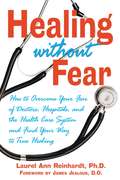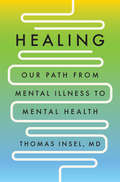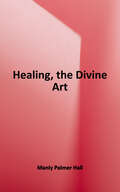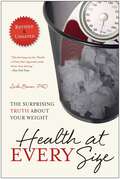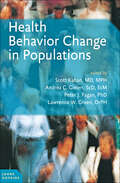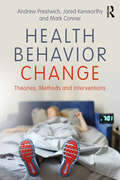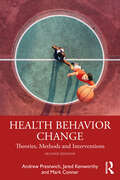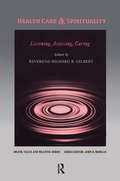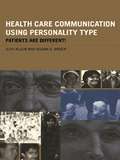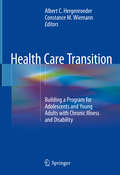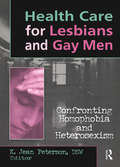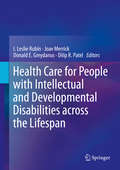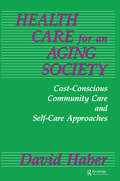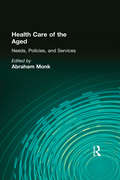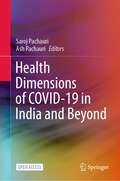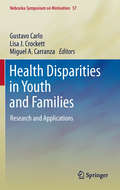- Table View
- List View
Healing the Traumatized Self: Consciousness, Neuroscience, Treatment (Norton Series on Interpersonal Neurobiology)
by Bessel van der Kolk David Spiegel Ruth Lanius Paul FrewenA neurobiological explanation of self-awareness and the states of mind of severely traumatized people. Cultivation of emotional awareness is difficult, even for those of us not afflicted by serious mental illness. This book discusses the neurobiology behind emotional states and presents exercises for developing self awareness. Topics include mood (both unipolar and bipolar), anxiety (particularly PTSD), and dissociative disorders. Frewen and Lanius comprehensively review psychological and neurobiological research, and explain how to use this research to become aware of emotional states within both normal and psychopathological functioning. Therapists will be able to help survivors of trauma, mood disorders, anxiety disorders, and dissociative disorders develop emotional awareness. The book also includes case studies, detailed instructions for clinicians, and handouts ready for use in assessment/therapy with patients/clients.
Healing the Unimaginable: Treating Ritual Abuse and Mind Control
by Alison MillerHealing the Unimaginable: Treating Ritual Abuse and Mind Control is a practical, task-oriented, instructional manual designed to help therapists provide effective treatment for survivors of these most extreme forms of child abuse and mental manipulation.
Healing the Wounded Heart: The Heartache of Sexual Abuse and the Hope of Transformation
by Dan B. AllenderFirst published in 1989, Dan Allender's The Wounded Heart has helped hundreds of thousands of people come to terms with sexual abuse in their past. <p><p> Now, more than twenty-five years later, Allender has written a brand-new book on the subject that takes into account recent discoveries about the lasting physical, emotional, relational, and spiritual ramifications of sexual abuse. <p><p> With great compassion Allender offers hope for victims of rape, date rape, incest, molestation, sexting, sexual bullying, unwanted advances, pornography, and more, exposing the raw wounds that are left behind and clearing the path toward wholeness and healing. Never minimizing victims' pain or offering pat spiritual answers that don't truly address the problem, he instead calls evil evil and lights the way to renewed joy. <p><p> Counselors, pastors, and friends of those who have suffered sexual harm will find in this book the deep spiritual guidance they need to effectively minister to the sexually broken around them. Victims themselves will find here a sympathetic friend to walk alongside them on the road to healing.
Healing the Wounds of Gukurahundi in Zimbabwe: A Participatory Action Research Project (The Anthropocene: Politik—Economics—Society—Science #19)
by Dumisani NgwenyaThis book is based on a participatory action research project carried out with a group of former Zimbabwe People's revolutionary Army (ZPRA) which was the armed wing of the Zimbabwe African People's Union (ZAPU) which was led by the late Joshua Nkomo. ZPRA was the primary target of Gukurahundi, a pogrom by the Mugabe government which left an estimated 20 000 civilians dead and countless others tortured in the early 1980s in Matebeleland, Zimbabwe. It has been almost 30 years since the violence ended, but there has never been an official healing and reconciliation programme or truth commission into the atrocities. The government chose the path of amnesia by granting a blanket amnesty to all involved. The regime has enforced a culture of silence over the event through repression and intimidation. The book is a culmination of a two year journey, by the group and the author, of an exploration of group-based self-healing approaches to the pain caused by the violence of Gukurahundi.
Healing through Relating: A Skill-Building Book for Therapists
by Jon FredericksonWould you like to be a more skilled therapist? Would you like to help the 50 percent of patients who drop out of therapy before they receive its full benefits? Would you like to connect with hard-to-reach patients so you can form a healing therapeutic alliance? While other books teach theory, this book will help you develop the specific skills you need to be an effective therapist. You can practice the exercises with a partner or with audio recordings, just like learning a language. And videos will show you how. Each of the forty-two skill-building exercises teaches a specific technique so you can successfully address typical impasses in therapy. Where you got stuck in the past, you’ll be able to move forward in the future. You will learn what to say so you can • Assess and regulate anxiety • Help patients develop and keep an effective focus that leads to change • Teach patients to see and let go of avoidance strategies • Work with patients who deny that they need therapy • Mobilize patients’ will to work toward a positive goal • Support patients so they can shift from denial to facing reality • Identify early signs of dropout so you can prevent it When you improve your relational skills, your patients can get better results.
Healing through the Dark Emotions: The Wisdom of Grief, Fear, and Despair
by Miriam Greenspan"We are all touched at some point by the dark emotions of grief, fear, or despair. In an age of global threat, these emotions have become widespread and overwhelming. While conventional wisdom warns us of the harmful effects of "negative" emotions, this revolutionary book offers a more hopeful view: there is a redemptive power in our worst feelings. Seasoned psychotherapist Miriam Greenspan argues that it's the avoidance and denial of the dark emotions that results in the escalating psychological disorders of our time: depression, anxiety, addiction, psychic numbing, and irrational violence. And she shows us how to trust the wisdom of the dark emotions to guide, heal, and transform our lives and our world.
Healing with Death Imagery (Imagery and Human Development Series)
by Anees Ahmad Sheikh Katharina S. SheikhSages of various traditions and ages have reiterated that we must incorporate the inevitability of death into the fabric of life to experience life's breadth and beauty. Imagery is an important tool in dealing with death, and this book is devoted to exploring many facets of this fascinating issue. It begins with an overview of ancient and modern approaches to the use of death imagery for therapeutic purposes, including a discussion of its possible benefits. Chapter 2, specifically exploring Stephen Levine's contributions in this area, shows that only by opening up to the reality of death can one make living a conscious process of growth. A number of excellent imagery-based experiential exercises are discussed in detail. Chapter 3 demonstrates the significance of confronting death through mental and artistic images; it discusses six examples of death-related religious and existential works of art.Recently there has been an upsurge of interest in near-death experiences and their salutary effects on attitudes, beliefs, and values. Of particular interest here are increases in spirituality, concern for others, an appreciation of life, and an enhanced sense of meaning and purpose in life. Chapter 4 presents a detailed critical overview of this field of investigation, with special emphasis on the transformatory after-effects of near-death experiences. Of all the major religions in the world, Buddhism is at the forefront of exploring the topic of death and dying and developing specific meditative exercises for confronting death.Chapter 5 presents an in-depth treatment of death imagery in Buddhist thought. Exploring the use of hypnosis for death rehearsal, Chapter 6 continues the theme that confrontation with death can lead to healthful consequences. A variation of this technique, hypnotic suicidal rehearsal, is also discussed: it seems to be effective for use with clients who are contemplating suicide. Case examples clarify the details of the process.Over the years, several clinicians have proposed the use of imagery for reconstructing death-related events and thereby facilitating the grieving process for individuals who are experiencing symptoms rooted in unfinished grieving. Chapter 7 gives an exhaustive account of the use of imagery for unresolved grieving, including a number of case histories. Researchers have perhaps devoted more time and energy to the investigation of death anxiety than any other death-related topic. Chapter 8 reviews the literature on death anxiety and death imagery, and demonstrates a core connection between the two phenomena. The authors claim that death imagery has the potential not only to ameliorate death anxiety but also to lead to a more authentic existence.In Chapter 9, the authors explain how death imagery can be used constructively in death education; they present several practical suggestions and specific guided imagery exercises. The volume closes with a presentation of a detailed death-imagery experiential exercise aimed at encountering death to enhance our appreciation of life. The reader will notice this thread running steadily throughout the book. This comprehensive book devoted to the role of death imagery in health and growth, perhaps the first of its kind, will be helpful in changing the rather sinister view of death, prevalent in our culture, to a deeper appreciation for its enhancing potential.
Healing with Nature: Mindfulness and Somatic Practices to Heal from Trauma
by Rochelle CalvertReconnect with Your Body and Nature to Heal from Trauma As psychologist and mindfulness teacher Rochelle Calvert explores in this powerful book, one of the greatest sources of healing from trauma is all around us — nature. Dr. Calvert shows how to relate to and connect with nature through the practice of mindfulness to calm and relax the nervous system, tune in to the somatic wisdom of the body to face lingering trauma and rewire it, and work with painful experiences to transform them in ways that heal the individual and contribute to healing the wider world. Healing with Nature pioneers a path not just to recovery but to lifelong healing and resilience.
Healing without Fear: How to Overcome Your Fear of Doctors, Hospitals, and the Health Care System and Find Your Way to True Healing
by James Jealous Laurel Ann ReinhardtA workbook for recognizing, releasing, and transforming fear in one's self and in our health care system. • Over 60 exercises for recognizing, releasing, and transforming fear to promote healing. • Includes case studies, transcribed dreamwork, and the author's personal story of healing. When Laurel Ann Reinhardt discovered a lump in her breast she witnessed firsthand how fear holds silent reign over the patient in the Western health care system and hinders the process of healing. This fear is systematically perpetuated by doctors and insurance agents, and it has become the cultural norm--undermining the foundation of all healing and the important work these providers are meant to perform. Drawing on the work of Rupert Sheldrake, Ken Wilbur, and Carl Jung, as well as her 20-plus years of experience as a clinical psychologist, Laurel Ann Reinhardt provides a thoughtful discussion about the existence, creation, and impact of this morphogenetic "field of fear" in the health care system. She provides us with the tools we need to recognize and release this fear and its harmful role in the healing process. From exercises for "expelling the breath of fear" and "talking back to fear" to "being heard and seen by physicians" and "dealing with the fears of our health care providers," Healing without Fear utilizes visualizations, journaling, chakra meditations, and dreamwork to teach both health care professionals and laypersons how to transform fear and allow true healing to begin.
Healing, Rebirth and the Work of Michael Eigen: Collected Essays on a Pioneer in Psychoanalysis
by Ken Fuchsman Keri S. CohenThis important book features collected essays on the distinguished psychoanalyst Dr Michael Eigen, who is an influential innovator within and beyond psychoanalysis. Drawing on the ideas of Bion, Winnicott, Kabbalah, and artists, Eigen’s work is noted for fusing spirituality with psychoanalysis and his extraordinary creativity. The book begins with Dr Eigen’s new essay "Rebirth: It’s been around a long time." The other essays feature a rich array of subjects and reflections, with many clinical examples and applications to domains beyond psychotherapy and include such titles as "Healing longing in the midst of damage: Eigen's psychoanalytic vision" and "Breakdown and recovery: Going Berserk and other rhythmic concerns." Dr Eigen is one of the most influential psychoanalysts of the current era and this collection of essays provides insightful discussion on his ideas. This celebration of Michael Eigen will fascinate any psychoanalyst interested in his work.
Healing: Our Path from Mental Illness to Mental Health
by Thomas InselA bold, expert, and actionable map for the re-invention of America&’s broken mental health care system.&“Healing is truly one of the best books ever written about mental illness, and I think I&’ve read them all." —Pete Earley, author of CrazyAs director of the National Institute of Mental Health, Dr. Thomas Insel was giving a presentation when the father of a boy with schizophrenia yelled from the back of the room, &“Our house is on fire and you&’re telling me about the chemistry of the paint! What are you doing to put out the fire?&” Dr. Insel knew in his heart that the answer was not nearly enough. The gargantuan American mental health industry was not healing millions who were desperately in need. He left his position atop the mental health research world to investigate all that was broken—and what a better path to mental health might look like. In the United States, we have treatments that work, but our system fails at every stage to deliver care well. Even before COVID, mental illness was claiming a life every eleven minutes by suicide. Quality of care varies widely, and much of the field lacks accountability. We focus on drug therapies for symptom reduction rather than on plans for long-term recovery. Care is often unaffordable and unavailable, particularly for those who need it most and are homeless or incarcerated. Where was the justice for the millions of Americans suffering from mental illness? Who was helping their families? But Dr. Insel also found that we do have approaches that work, both in the U.S. and globally. Mental illnesses are medical problems, but he discovers that the cures for the crisis are not just medical, but social. This path to healing, built upon what he calls the three Ps (people, place, and purpose), is more straightforward than we might imagine. Dr. Insel offers a comprehensive plan for our failing system and for families trying to discern the way forward. The fruit of a lifetime of expertise and a global quest for answers, Healing is a hopeful, actionable account and achievable vision for us all in this time of mental health crisis.
Healing: The Divine Art
by Manly Palmer Hall2021 Reprint of the 1943 Edition. Profusely Illustrated. Facsimile of the original edition and not reproduced with Optical Recognition Software. <p><p>The purpose of this book is to make available in one volume a wide variety of evidence bearing on the theory and practice of Metaphysical Medicine, and to point out certain broad and invariable principles that bear upon the practitioner and his practice. Hall covers Shamanic healing, The American Indian Medicine Man, The Healing Cult of Asculapius, Healing during the Early Christian Church, Modern Healing Cults, Esoteric Physiology, The Pineal Gland and more.
Health At Every Size: The Surprising Truth About Your Weight
by Linda Bacon Lindo BaconFat isn't the problem. Dieting is the problem. A society that rejects anyone whose body shape or size doesn't match an impossible ideal is the problem. A medical establishment that equates "thin" with "healthy" is the problem. The solution? Health at Every Size. Tune in to your body's expert guidance. Find the joy in movement. Eat what you want, when you want, choosing pleasurable foods that help you to feel good. You too can feel great in your body right now—and Health at Every Size will show you how. Health at Every Size has been scientifically proven to boost health and self-esteem. The program was evaluated in a government-funded academic study, its data published in well-respected scientific journals. Updated with the latest scientific research and even more powerful messages, Health at Every Size is not a diet book, and after reading it, you will be convinced the best way to win the war against fat is to give up the fight.
Health Behavior Change in Populations
by Peter J. Fagan Scott Kahan, MD, MPH Andrea C. Gielen, ScD, ScM Lawrence W. Green, DrPHFocuses on today’s major public health concerns to teach students the principles of population health behavior and behavior change.The single greatest way to improve health and quality of life is not by developing new medical approaches, but by addressing harmful personal behaviors. These behaviors—which include tobacco, alcohol, and drug use, diet, and physical activity—play a significant role in the risk for and development, treatment, and management of the most common causes of disease, disability, and death in the modern world. Health Behavior Change in Populations is designed to teach students and practitioners strategic principles for creating positive behavioral change on a population level. With an emphasis on the application of theory and research to practice, this textbook presents current and future public health professionals with a range of methods geared towards helping people make healthy choices, from informing the individual to modifying the surroundings and circumstances that drive decision-making. Written and edited by experts in the health professions, the book is arranged into three sections: State of the Field, State of the Science, and Cross-Cutting Issues. The chapters within these sections include learning objectives with boldfaced keywords and a glossary of terms. Each chapter addresses• The magnitude of the public health burden• Key determinants and conceptual framework for behaviors and behavior change, including individual, familial, interpersonal, community, sociocultural, structural, and political perspectives• Current evidence-based interventions and best practices• Roles for key stakeholders, including health plans, employers/workplace, health departments/agencies, sectors such as recreational and agricultural, policymakers, community groups/advocates, clinics/clinicians, researchers, and funding institutions • Considerations for implementation, evaluation, and translation
Health Behavior Change: Theories, Methods and Interventions
by Mark Conner Andrew Prestwich Jared KenworthyWe live in an era where people live longer but also suffer from more chronic illnesses. Yet these two issues present not only significant challenges to healthcare professionals, but also governments seeking cost-effective ways to manage their health and social care budgets. Encouraging people to live healthier lifestyles is, therefore, a fundamental issue for both those at risk as well as for society as a whole. This is the first textbook to present not only the theoretical foundations that explain health behavior change but also the methods by which change can be assessed and the practical contexts where theory and method can be applied. Covering behavior change aimed at improving health as well as preventing disease, it places behavior change firmly in context with the social and demographic changes which make it such an urgent issue, from the rise in levels of obesity to an aging population. The book considers the role of individuals but also other important influences on health behavior, such as the environment in which people live, public policy and technological changes. Fostering a critical perspective, and including case studies in each chapter with key issues highlighted throughout, the book provides a complete understanding of health behavior change, from its theoretical building blocks to the practical challenges of developing and testing an intervention. It will be essential reading for students and researchers of health psychology, public health and social work, as well as any professional working in this important area.
Health Behavior Change: Theories, Methods and Interventions
by Mark Conner Andrew Prestwich Jared KenworthyThe new and updated edition of Health Behavior Change: Theories, Methods and Interventions, provides a complete understanding of health behavior change, from its theoretical building blocks to the practical challenges of developing and testing an intervention. Based on the latest evidence in the field, the authors present a theory-driven, scientific approach to understanding and changing health behaviors, examining the theories that explain health behavior, the techniques that most effectively change health behavior, and the methods and statistical approaches essential to generating the underpinning evidence. This approach is presented in the context of both health promoting behaviors such as healthy eating, and health risk behaviors such as smoking, and considers not only the role of individuals but also other important influences on health behavior including the environment, policy, and technology.Among other additions, the revised edition includes the following features: More classic and modern theories explained and critiqued Coverage of issues related to tackling COVID-19 through behavior change Consideration of the replicability crisis, its causes, impact and potential solutions Wider coverage of methods including different types of randomized trials, pilot studies, feasibility studies, consensus methods, N-of-1 studies and megastudies Expanded critical skills toolkit Fostering a critical perspective, the book includes features to enable readers to better evaluate evidence and Burning Issue Boxes to highlight relevant, topical issues in the field. It will be essential reading for students and researchers of health psychology, public health and social work, as well as any professional working in this important area, particularly those tasked with reducing the high proportion of individuals failing to meet national health behavior targets.
Health Care & Spirituality: Listening, Assessing, Caring
by Richard B. GilbertFew areas in life have experienced the rapid pace of change that has been the experience of health care. It's an area where nothing feels "safe" and everything is threatened with reexamination and redefinition. Accompanying this situation is a new appreciation for the human spirit and the gift of things spiritual, including the soul of the work place. Addressing this situation is a vital new book "Health Care and Spirituality: Listening, Assessing, Caring" an anthology of the human predicament, the health care professional's story and the health care work place. "Health Care and Spirituality" explores this area that is continually being introduced to new treatments, new challenges, new people, new regulations, new expectations, and new time limits.
Health Care Communication Using Personality Type: Patients are Different!
by Judy Allen Susan A. BrockThis groundbreaking text draws upon examples from everyday health care situations to demonstrate that the behaviour differences we all experience in others actually fit within a readily understandable framework (the MBI).
Health Care Transition: Building A Program For Adolescents And Young Adults With Chronic Illness And Disability
by Albert C. Hergenroeder Constance M. WiemannThis comprehensive book thoroughly addresses all aspects of health care transition of adolescents and young adults with chronic illness or disability; and includes the framework, tools and case-based examples needed to develop and evaluate a Health Care Transition (HCT) planning program that can be implemented regardless of a patient’s disease or disability. Health Care Transition: Building a Program for Adolescents and Young Adults with Chronic Illness and Disability is a uniquely inclusive resource, incorporating youth/young adult, caregiver, and pediatric and adult provider voices and perspectives. Part I of the book opens by defining Health Care Transition, describing the urgent need for comprehensive transition planning, barriers to HCT and then offering a framework for developing and evaluating health care transition programs. Part II focuses on the anatomic and neuro-chemical changes that occur in the brain during adolescence and young adulthood, and how they affect function and behavior. Part III covers the perspectives of important participants in the HCT transition process – youth and young adults, caregivers, and both pediatric and adult providers. Each chapter in Part IV addresses a unique aspect of developing HCT programs. Part V explores various examples of successful transition from the perspective of five key participants in the transition process - patients, caregivers, pediatric providers, adult providers and third party payers. Related financial matters are covered in part VI, while Part VII explores special issues such as HCT and the medical home, international perspectives, and potential legal issues. Models of HCT programs are presented in Part VIII, utilizing an example case study. Representing perspectives from over 75 authors and more than 100 medical centers in North America and Europe, Health Care Transition: Building a Program for Adolescents and Young Adults with Chronic Illness and Disability is an ideal resource for any clinician, policy maker, caregiver, or hospitalist working with youth in transition.
Health Care for Lesbians and Gay Men: Confronting Homophobia and Heterosexism
by K Jean PetersonHealth Care for Lesbians and Gay Men educates practitioners about the special needs of gay and lesbian patients and how to look critically at the impact of homophobia and heterosexism on the provision of care. It provides an overview of critical health care issues for lesbians and gay men and offers concrete suggestions to health practitioners and social workers on how to address these issues in order to guarantee the best care for their patients and clients. Authors in Health Care for Lesbians and Gay Men give health care providers and mental health workers practical interventions; suggestions for advocacy, social change, grassroots efforts, and alternative programs; and lessons about how to use existing procedures to more effectively meet the unique health care needs of gays and lesbians. Practitioners also learn how to utilize legal action in securing and protecting patients’and clients’personal health care wishes. Chapters in this book cover: how homophobia and negative attitudes can directly compromise the care given to lesbians and gay men. heterosexism and biases which exclude the partners of gay men and lesbians from participating in the care of their loved ones. legal issues and the need for legal recognition of gay and lesbian relationships, both to enhance the provision of care and for financial access to health care presently available to only heterosexual, married couples. legal protection and special legal documents that ensure that the wishes of gay men and lesbians are honored and the integrity of their relationships not violated.Health Care for Lesbians and Gay Men starts with special issues confronting adolescents and the special role health care providers can play in supporting the struggles of lesbian and gay adolescents. It then continues to look at these issues over the life cycle. Three themes emerge as authors try to explain problems and possible solutions for lesbians and gay men seeking health care: the pervasive homophobia and heterosexism found throughout the health care system and the impact these attitudes and beliefs have on the health care of lesbians and gay men; the need for education in professional programs on special health issues of gay men and lesbians; and the critical role that social workers can play in both educating others about the special needs of their gay and lesbian clients and in advocating for their clients in various health care settings.Health Care for Lesbians and Gay Men is essential reading for social work and social service practitioners and students working in the health care field, advanced undergraduates and graduate students of social work, professionals and students of nursing and medicine, and others concerned with the quality and equality of health care services. It urges students and professionals to challenge and evaluate their own attitudes, beliefs, and behaviors in order to ensure quality services to all clients and patients.
Health Care for People with Intellectual and Developmental Disabilities across the Lifespan
by Donald E. Greydanus Dilip R. Patel Joav Merrick I. Leslie RubinThis book provides a broad overview of quality health care for people with intellectual and developmental disabilities (IDD). It focuses on providing the reader a practical approach to dealing with the health and well-being of people with IDD in general terms as well as in dealing with specific conditions. In addition, it offers the reader a perspective from many different points of view in the health care delivery system as well as in different parts of the world. This is the 3rd , and much expanded edition, of a text that was first published in 1989 (Lea and Fibiger). The second edition was published in 2006 (Paul Brookes) and has been used as a formal required text in training programs for physicians, nurses and nurse practitioners as well as by administrators who are responsible for programs serving people with IDD. This book is considered the "Bible" in the field of health care for people with IDD since 1989 when the first edition came out.
Health Care for an Aging Society: Cost-Conscious Community Care and Self-Care Approaches (Death Education, Aging and Health Care)
by David HaberFirst published in 1989. Routledge is an imprint of Taylor & Francis, an informa company.
Health Care of the Aged: Needs, Policies, and Services
by Abraham MonkFocusing on the need for developing new service delivery models for the aged, Health Care of the Aged examines fiscal, political, and social criteria influencing this challenge of the 1990s. The aged are caught in the sweeping changes currently occuring in the financing, organizing, and delivery of human and health care services. From various perspectives, this new book will help shape the direction for elderly health care program development and implementation. With an emphasis on greater long-term care in either home, community, or institutional settings, this important book will increase the understanding for a comprehensive, effective policy designed to carry the growing number of elderly through this decade and into the next. As roles and issues change, this valuable book will become increasingly important to those involved in providing services and care to the elderly. Health care administrators, policymakers, social workers, physical and occupational therapists, and caregivers will benefit from the expertise presented in Health Care of the Aged.
Health Dimensions of COVID-19 in India and Beyond
by Saroj Pachauri Ash PachauriThis open access book addresses the multiple health dimensions posed by the COVID-19 pandemic in India and other countries including nine in Asia, five in Sub-Saharan Africa, and New Zealand. It explores the impact of the pandemic on mental health, sexual and reproductive health and rights, health financing, self-care, and vaccine development and distribution. The contributing authors discuss its impact on vulnerable populations, including interstate migrants and female sex workers. The significant role of media and communications, rapid dissemination of information in social media, and its impact during the COVID-19 pandemic era are discussed. It closes with lessons learned from the experiences of countries that have contained the pandemic. With contributions from experts from around the world, this book presents solutions of problems that relate to COVID-19. It is a valuable resource appealing to a wide readership across the social sciences and the humanities. Readers include governments, academicians, researchers, policy-makers, program implementers, as well as lay persons.
Health Disparities in Youth and Families
by Lisa J. Crockett Gustavo Carlo Miguel A. CarranzaAmid its growing diversity and shifting demographics, the U.S. is still home to glaring health inequities by race, ethnicity, and class. Yet while it is customary to identify poverty as their root cause, other complex mechanisms are involved in their perpetuation. Based on recent major studies on African-American, Latino, Asian-American, and Native American populations, Health Disparities in Youth and Families offers a thorough, nuanced examination of a wide range of causal--and protective--factors. Rigorous theories and models take into account cultural, contextual, and personal variables, including the roles of family identity, school, and neighborhood, and motivation toward health awareness (with attention paid to less frequently studied phenomena such as within-group inequalities and the Hispanic Health Paradox). Contributors approach their subjects with realism as well as optimism as the book: povides reliable information on the scope and etiology of health disparities, identifies the methodological and political challenges associated with this issue, proposes comprehensive, integrative models for understanding disparities, features examples of innovative programs for improving minority health, includes an in-depth chapter on substance use and mental health among Native American youth, offers a useful starting point for the exchange of ideas necessary to address health disparities. A provocative resource on a pressing social concern, Health Disparities in Youth and Families is necessary reading for health policy researchers, health care providers, and others dedicated to better health outcomes for all Americans.
